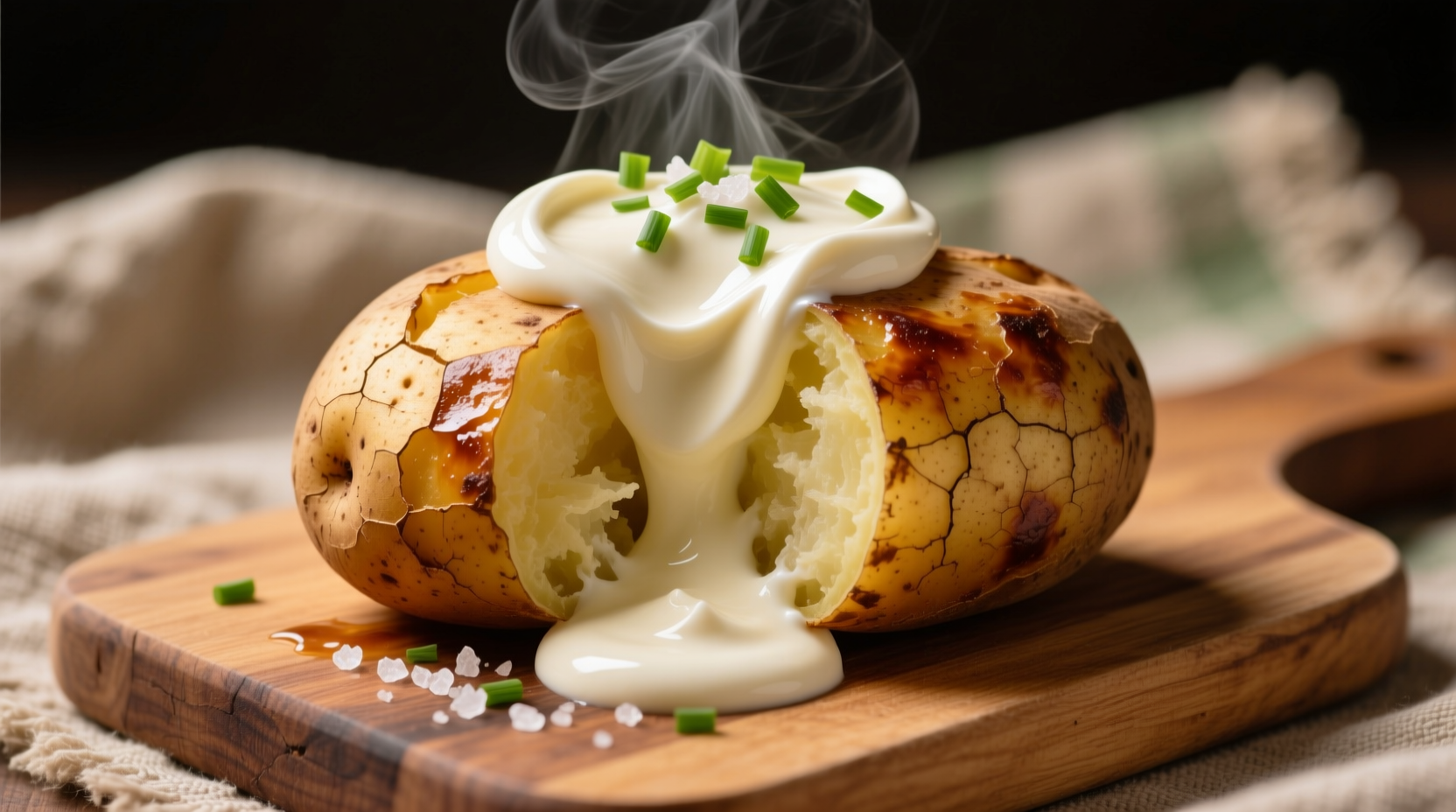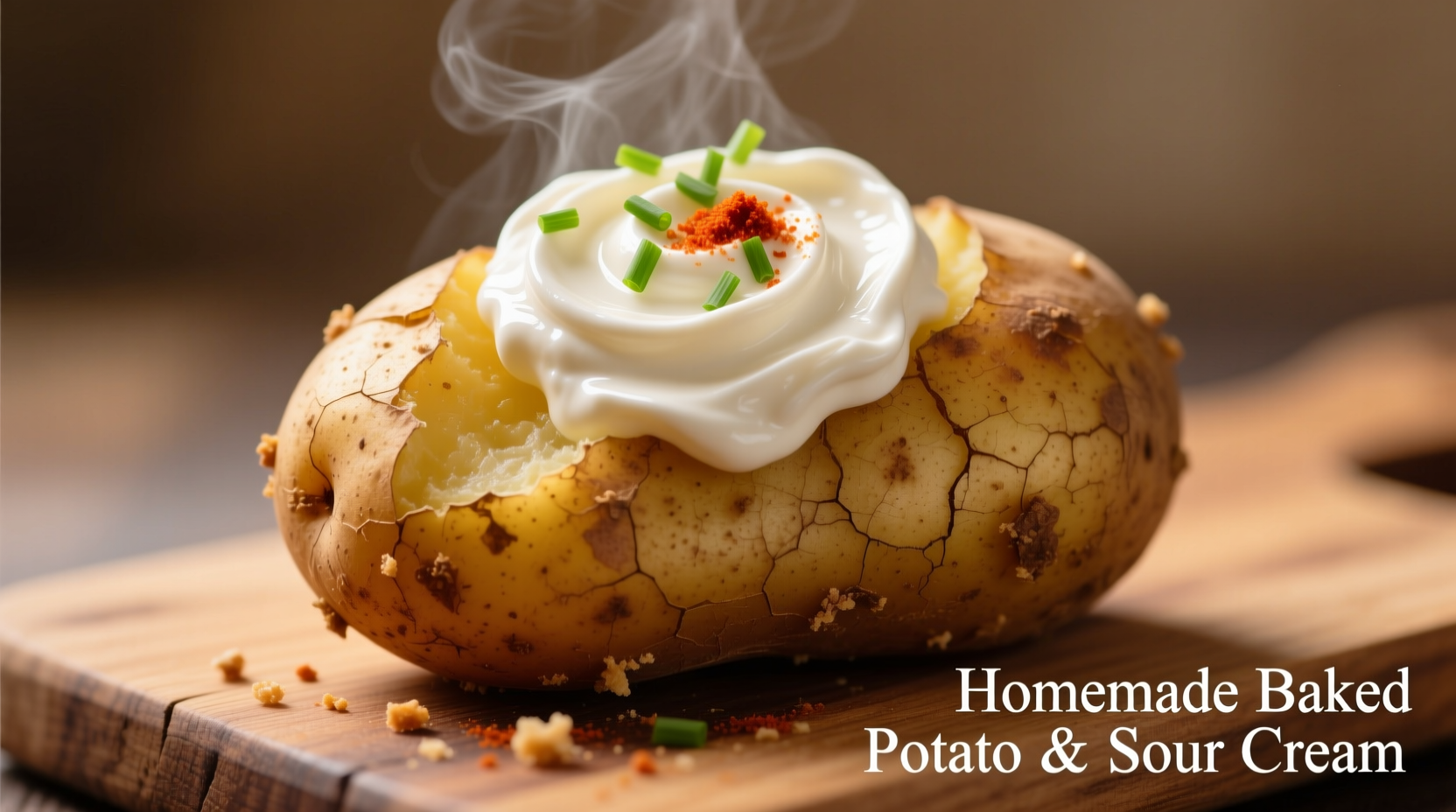Mastering the Art of Baked Potatoes with Sour Cream
When prepared correctly, a baked potato with sour cream transforms humble ingredients into culinary perfection. This guide reveals professional techniques that elevate this simple dish from cafeteria staple to restaurant-quality comfort food. Whether you're cooking for yourself or serving guests, understanding the science behind the perfect potato-sour cream pairing will transform your results.
Why This Classic Combination Works
The magic happens through flavor chemistry. Potatoes contain starches that absorb flavors exceptionally well when hot, while sour cream's lactic acid cuts through the starch's richness. Food scientists at the USDA Agricultural Research Service confirm that the temperature contrast (hot potato, cool sour cream) creates optimal flavor release as the sour cream melts into the potato's crevices.
| Flavor Component | Role in the Dish | Optimal Temperature |
|---|---|---|
| Potato starch | Absorbs flavors, creates fluffy texture | 210°F (internal) |
| Sour cream fat | Carries flavor compounds, provides richness | 65-70°F (room temperature) |
| Lactic acid | Cuts through starch, balances flavors | Melts at 90°F |
Selecting Your Foundation: The Perfect Potato
Russet potatoes remain the gold standard for baking due to their high starch content and thick skin that crisps beautifully. According to the Potato Association of America, russets contain 20-22% starch compared to 15-17% in Yukon Golds, making them ideal for that signature fluffy interior. Choose potatoes that feel heavy for their size with smooth, unblemished skin.

Professional Baking Techniques
Follow these chef-tested steps for flawless results every time:
- Preparation: Scrub potatoes thoroughly and pierce skin 4-5 times with a fork
- Seasoning: Rub with olive oil and coarse salt (creates crispy skin)
- Baking: Place directly on oven rack at 400°F for 45-60 minutes
- Doneness test: Internal temperature should reach 210°F
- Resting: Let stand 5 minutes before cutting to redistribute moisture
The Sour Cream Factor: Quality Matters
Not all sour creams deliver equal results. Full-fat varieties (minimum 18% milk fat) provide the richest mouthfeel and best flavor absorption. The FDA requires sour cream to contain this minimum fat content to bear the name. For dietary restrictions:
- Dairy-free: Cashew-based alternatives work best (soak 1 cup cashews overnight)
- Lower fat: Greek yogurt blends well but adds more tang
- Vegan: Coconut cream with lemon juice mimics texture
Serving Perfection: Temperature is Key
Professional chefs emphasize temperature management as the secret to optimal flavor. Always apply room-temperature sour cream to hot potatoes - the thermal shock causes the sour cream to melt into the potato's starch pockets rather than sitting on top. This technique, documented in On Food and Cooking by Harold McGee, maximizes flavor integration.
Nutritional Profile: Balancing Indulgence
A medium baked potato (5.3 oz) with 2 tablespoons of sour cream provides:
- Approximately 220 calories
- 37g carbohydrates (including 4g fiber)
- 5g protein
- 7g fat (5g saturated)
The Dietary Guidelines for Americans note that potatoes provide significant potassium and vitamin C when consumed with skin. To create a balanced meal, pair with lean protein and vegetables.
Common Mistakes to Avoid
Even experienced cooks make these errors:
- Wrapping in foil: Creates steamed texture rather than baked
- Cold sour cream: Doesn't integrate properly with hot potato
- Overloading toppings: Masks the delicate potato flavor
- Peeling before baking: Causes moisture loss and texture issues
Creative Variations Worth Trying
While classic preparation shines, these adaptations honor regional traditions:
- Midwestern style: Add crumbled bacon and chives
- Texan twist: Mix sour cream with roasted jalapeños
- Healthy upgrade: Top with Greek yogurt and smoked paprika
- Gourmet version: Infuse sour cream with truffle oil
Food historians note that the potato-sour cream pairing gained popularity in North America during the 1950s as refrigeration became widespread, allowing reliable sour cream storage. This simple combination represents the perfect marriage of European dairy traditions and New World tubers.
Perfect Pairings for Complete Meals
While delicious alone, baked potatoes with sour cream shine when paired thoughtfully:
- Protein partners: Grilled chicken, roast beef, or salmon
- Vegetable complements: Steamed broccoli or roasted asparagus
- Seasonal variations: Apple sauce in fall, fresh herbs in summer
Remember that the sour cream's tang balances rich proteins, while the potato's starch absorbs flavorful juices from accompanying meats.
Frequently Asked Questions
How do I prevent my baked potato from becoming dry?
Avoid overbaking - remove potatoes when internal temperature reaches 210°F. Let them rest 5 minutes before cutting to allow moisture redistribution. Never wrap in foil during baking as this creates steamed rather than baked texture.
Can I make baked potatoes ahead of time?
Yes, but with proper technique. Bake completely, then cool to room temperature before refrigerating. To reheat, wrap in damp paper towel and microwave for 2-3 minutes, or place in 350°F oven for 15-20 minutes. Always add fresh sour cream after reheating.
What's the best way to store leftover sour cream?
Transfer unused sour cream to an airtight container, pressing plastic wrap directly onto the surface to prevent oxidation. Store in the coldest part of your refrigerator (not the door) for up to 7-10 days. Never return unused sour cream to the original container after serving.
Why does my sour cream sometimes curdle on hot potatoes?
Curdling occurs when sour cream hits extreme heat. Prevent this by letting potatoes rest 2-3 minutes after cutting before adding sour cream. Room-temperature sour cream is less likely to curdle than cold. If curdling happens, gently stir to reincorporate.











 浙公网安备
33010002000092号
浙公网安备
33010002000092号 浙B2-20120091-4
浙B2-20120091-4